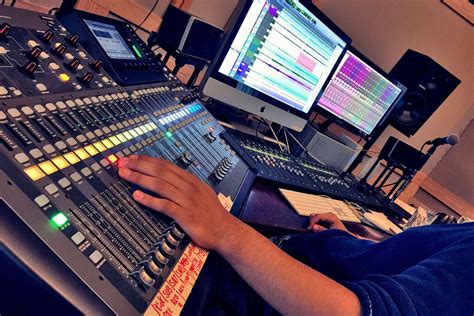Are you passionate about the way sound works and how it can be manipulated to create optimal auditory experiences? If so, you may want to consider a career in acoustical engineering. This fascinating field delves into the science of sound, using principles of physics and engineering to control and manipulate sound waves for a variety of purposes. In this blog post, we’ll explore the world of acoustical engineering, from understanding sound waves and frequency to the role of acoustical engineers in design. We’ll also delve into the techniques used for noise control, the design of concert halls and recording studios, and the enhancement of architectural design through acoustics. Join us as we investigate the materials used for sound insulation and look at future trends in acoustical engineering, and discover the truly exciting and impactful world of acoustical engineering.
Table of Contents
Introduction to Acoustical Engineering
Acoustical Engineering is a fascinating field that encompasses the science and technology of sound. It involves the study of sound waves, frequency, and their application in various industries. Acoustical Engineers are responsible for designing and creating systems that control sound and vibration in different environments.
There is a wide range of applications for acoustical engineering, from designing concert halls and recording studios to reducing noise in urban environments. The field relies on a combination of physics, engineering, and material science to solve complex problems related to sound transmission and reception.
Acoustical engineers work closely with architects, musicians, and urban planners to create spaces that are optimized for sound quality and comfort. With the demand for better acoustics in buildings and public spaces, the role of acoustical engineers is becoming increasingly important in modern society.
As we delve into the world of acoustical engineering, we will explore the key concepts and techniques that drive this field forward, as well as the future trends that are shaping the industry.
Understanding Sound Waves and Frequency
When it comes to sound waves and frequency, there’s a fascinating world of physics behind the audio we experience. Sound waves are essentially a series of compressions and rarefactions traveling through a medium, such as air, and these movements create the sensation of hearing. Frequency, on the other hand, refers to the number of complete oscillations a wave completes in a given time. In simpler terms, it’s the pitch or tone of the sound we perceive.
Understanding the physics of sound waves involves delving into the concept of wavelength, which is the distance between two consecutive points that have the same phase of the wave. As the frequency of a sound wave increases, its wavelength decreases, resulting in higher pitched sounds. Conversely, lower frequencies are associated with longer wavelengths and lower tones. This relationship between frequency and pitch is at the core of our perception of sound.
Furthermore, the study of sound waves and frequency is crucial in various fields, including music production, acoustical engineering, and even medical diagnostics. For instance, acoustic engineers rely on an in-depth understanding of sound waves to design spaces that optimize the way audio is perceived, while medical professionals use frequency analysis in techniques like ultrasound imaging to visualize internal structures within the human body.
Overall, delving into the world of sound waves and frequency opens up a wide array of possibilities and applications, making it an enthralling subject for anyone interested in the science of sound.
Exploring the Field of Acoustics
Acoustics is a fascinating field that encompasses the study of sound and its behavior in various environments. It is a multidisciplinary field that draws on physics, engineering, and psychology to understand how sound waves are produced, transmitted, and perceived. Acoustics is not just about the science of sound, but also about the practical applications of that knowledge in designing spaces, controlling noise, and enhancing the quality of sound in various settings.
One of the key areas of focus in the field of acoustics is the study of sound waves and frequency. Sound waves are mechanical vibrations that travel through a medium, such as air, water, or solid materials. Understanding how these waves propagate and interact with different surfaces and materials is essential for designing spaces that have optimal acoustics, whether it’s a concert hall, recording studio, or office building.
Acoustical engineers play a crucial role in design by applying their knowledge of sound and vibration to create spaces that are acoustically pleasing and functional. They use a variety of techniques for noise control, sound isolation, and sound reinforcement to achieve the desired acoustic properties in different environments. From designing concert halls and auditoriums to enhancing architectural acoustics, acoustical engineers are involved in a wide range of projects that aim to improve the quality of sound in various spaces.
As technology advances, the field of acoustics continues to evolve, with researchers investigating new materials for sound insulation, exploring the use of acoustics in architectural design, and developing innovative techniques for enhancing room acoustics. The future of acoustical engineering holds exciting possibilities for creating spaces that not only sound great but also contribute to the overall well-being of the people who occupy them.
The Role of Acoustical Engineers in Design
Acoustical engineers play a crucial role in the design process of various architectural and engineering projects. They are responsible for ensuring that the sound quality and noise levels within a space are carefully considered and optimized. Whether it’s designing a state-of-the-art concert hall or a modern office building, acoustical engineers are integral to the success of the final design.
With their expertise in sound waves and frequency, acoustical engineers are able to analyze and manipulate the way sound behaves within a given environment. This involves considering factors such as reverberation, reflection, and absorption to create the desired acoustic environment. By utilizing advanced acoustical engineering techniques for noise control, they are able to mitigate unwanted noise and create a comfortable and productive environment.
Furthermore, acoustical engineers also work closely with architects and interior designers to ensure that the room acoustics in recording studios and performance spaces are optimized for the intended use. They take into account the materials used in construction, the layout of the space, and the overall design to achieve the best possible sound quality.
As technology continues to advance, the role of acoustical engineers in design is becoming increasingly important. They are constantly investigating materials for sound insulation and exploring innovative methods to enhance architectural design through acoustics. This allows them to stay ahead of future trends in acoustical engineering and continue to push the boundaries of what is possible in the field of sound and noise control.
Acoustical Engineering Techniques for Noise Control
Acoustical engineering techniques for noise control are essential for maintaining peaceful and productive environments in a variety of settings. Whether it’s in urban areas, industrial spaces, or residential buildings, noise can have a significant impact on people’s health and well-being. Therefore, it’s important for acoustical engineers to employ effective techniques to minimize and manage noise levels.
One of the primary techniques used in acoustical engineering for noise control is sound insulation. This involves the use of materials and design strategies to prevent the transmission of sound from one space to another. By creating barriers and implementing proper construction techniques, acoustical engineers can effectively reduce the impact of noise on individuals within a given environment.
Another important technique is noise absorption. This involves the use of specialized materials and structures to absorb sound energy and prevent it from reflecting and reverberating within a space. By strategically placing acoustic panels, ceiling tiles, and other sound-absorbing materials, acoustical engineers can significantly reduce noise levels and create more comfortable and functional environments.
Furthermore, acoustical engineers often employ noise control through the use of sound masking techniques. This involves the introduction of background noise or the manipulation of existing sound sources to help mask and minimize the impact of unwanted noises. By carefully controlling the ambient sound levels, acoustical engineers can create environments that are more conducive to concentration, relaxation, and overall well-being.
Designing Concert Halls and Auditoriums for Optimal Sound
Designing concert halls and auditoriums for optimal sound is a crucial aspect of acoustical engineering. The goal is to create a space where the audience can receive the best possible sound experience. This involves understanding the principles of acoustics and employing various techniques to achieve the desired outcome.
One of the key considerations in designing concert halls and auditoriums is the placement of sound-reflective and sound-absorbing materials. This involves strategically positioning materials such as diffusers, absorbers, and reflectors to control the reverberation and echos within the space. By manipulating sound reflections, acoustical engineers can create an environment where the sound reaches the audience with optimal clarity and balance.
In addition to material placement, the shape and dimensions of the concert hall or auditorium play a significant role in determining the quality of sound. Acoustical engineers use specialized software to simulate and analyze the behavior of sound waves within different architectural designs. This allows them to make informed decisions about the layout of the space, ensuring that the sound is evenly distributed and reaches every seat in the venue.
Furthermore, the choice of sound reinforcement systems and audio equipment is a critical aspect of designing concert halls and auditoriums for optimal sound. Acoustical engineers work closely with audio professionals to select the appropriate loudspeakers, amplifiers, and signal processing equipment that will complement the architectural design and deliver high-quality sound to the audience.
The Importance of Room Acoustics in Recording Studios
When it comes to recording music, the room acoustics play a crucial role in capturing the best possible sound quality. The way sound waves behave within a room can greatly impact the overall recording and mixing process. In order to create a professional and high-quality recording, it is essential to understand and optimize the acoustics of the studio environment.
One of the key aspects of room acoustics in recording studios is the control of reverberation and reflections. Excessive reverberation can result in a muddy and unclear sound, while too many reflections can lead to a loss of clarity and definition. By properly treating the surfaces of the recording room with materials such as acoustic panels, diffusers, and bass traps, engineers can effectively manage these acoustic phenomena and create a controlled and balanced sound environment.
Another important consideration in room acoustics is the reduction of external noise interference. Recording studios often have to contend with external noises such as street traffic, HVAC systems, and other environmental sounds. Through the use of soundproofing techniques and materials, engineers can minimize the impact of these external noises and create an isolated and quiet recording environment.
Ultimately, the importance of room acoustics in recording studios cannot be overstated. By carefully optimizing the acoustics of the recording space, engineers are able to capture the true essence of the music being performed and ensure that the final recording is of the highest possible quality.
Using Acoustics to Enhance Architectural Design
Acoustics play a crucial role in the design and construction of buildings, ranging from concert halls and auditoriums to office spaces and residential homes. The way sound behaves within a space is a key consideration for architects and designers, as it directly impacts the comfort and functionality of the building. When acoustics are carefully integrated into the architectural design, they can greatly enhance the overall experience of the space for its occupants.
One of the primary ways in which acoustics can enhance architectural design is through the use of sound-absorbing materials and surfaces. These materials are strategically placed to reduce sound reflection and reverberation, creating a more pleasant and intelligible acoustic environment. Additionally, the use of sound-reflecting surfaces in certain areas can help to distribute sound evenly throughout a space, improving the overall auditory experience.
Another important aspect of using acoustics to enhance architectural design is the consideration of the building’s layout and geometry. By carefully planning the shape and layout of a space, architects can optimize the propagation of sound and minimize disruptive noise. This can be especially important in environments such as open-plan offices or educational facilities, where the control of sound is paramount to the productivity and well-being of the occupants.
Furthermore, the integration of advanced audio systems and technology into architectural design allows for even greater control and customization of the acoustic environment. Through the use of sound masking systems, for example, designers can mitigate distracting background noise and provide a more comfortable and private space for building occupants.
Investigating Materials for Sound Insulation
When it comes to creating a quiet and peaceful environment, especially in urban areas, the use of sound insulation materials is crucial. These materials play a vital role in reducing the transmission of sound from one area to another, whether it’s in a residential, commercial, or industrial setting.
Acoustical engineers are constantly researching and investigating materials for sound insulation to develop innovative solutions that are not only effective but also environmentally friendly. With the advancements in technology and manufacturing processes, there is a wide range of materials available for sound insulation, each with its unique properties and applications.
From traditional materials like fiberglass and foam to newer alternatives such as recycled denim and cellulose, the options for sound insulation have expanded significantly. These materials are tested for their acoustic performance, fire resistance, and impact on indoor air quality to ensure that they meet the necessary standards and regulations.
Furthermore, ongoing research in the field of acoustics also explores the use of natural and sustainable materials for sound insulation, reflecting a growing emphasis on eco-friendly and energy-efficient solutions. This emphasis presents an exciting opportunity to develop advanced materials that not only provide superior sound insulation but also contribute to a more sustainable built environment.
Future Trends in Acoustical Engineering
As technology continues to advance at a rapid pace, the future of acoustical engineering is looking brighter than ever. With the development of new materials and techniques, acoustical engineers are poised to make incredible strides in the field of sound control and design. One of the most exciting trends in acoustical engineering is the use of 3D printing to create customized acoustic panels and building materials. This technology allows for unprecedented levels of control over the shape and composition of sound-dampening materials, leading to highly effective noise reduction solutions.
Another trend that is shaping the future of acoustical engineering is the integration of artificial intelligence (AI) and machine learning into the design process. By analyzing massive data sets and simulating sound wave interactions, AI programs can help engineers optimize the acoustics of a space with unprecedented precision. This level of computational power has the potential to revolutionize the way acoustic environments are designed, leading to more efficient and effective solutions for controlling sound.
Additionally, the growing trend of sustainable design is starting to have a major impact on acoustical engineering. As society becomes more focused on reducing its environmental footprint, acoustical engineers are exploring the use of eco-friendly materials and construction techniques. This includes the development of biodegradable sound insulation materials and the use of sustainable building practices to create acoustically superior spaces. The integration of sustainable design principles into acoustical engineering has the potential to not only improve the sonic quality of a space, but also contribute to a healthier planet.
Looking ahead, it’s clear that acoustical engineering is on the brink of some truly transformative developments. From the use of cutting-edge technologies like 3D printing and AI, to the embrace of sustainable design practices, the future of acoustical engineering is full of exciting potential. As these trends continue to evolve, acoustical engineers will be able to create better, more immersive sound experiences while minimizing the impact on the environment.






